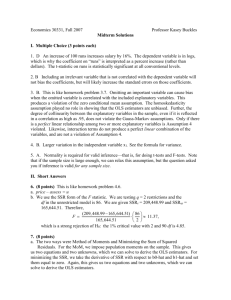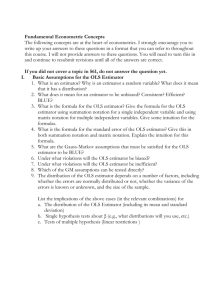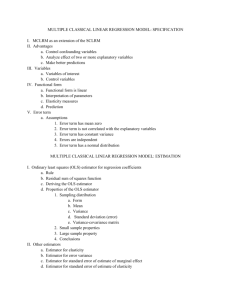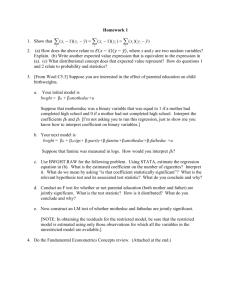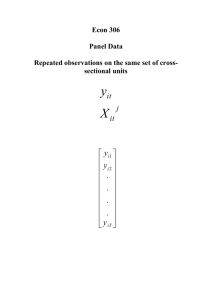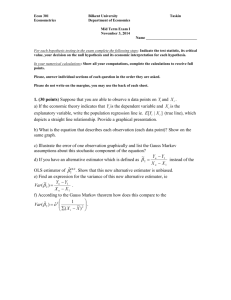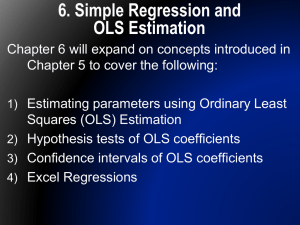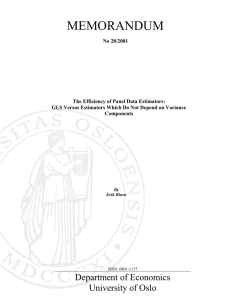Lecture 5: OLS Inference under Finite
advertisement
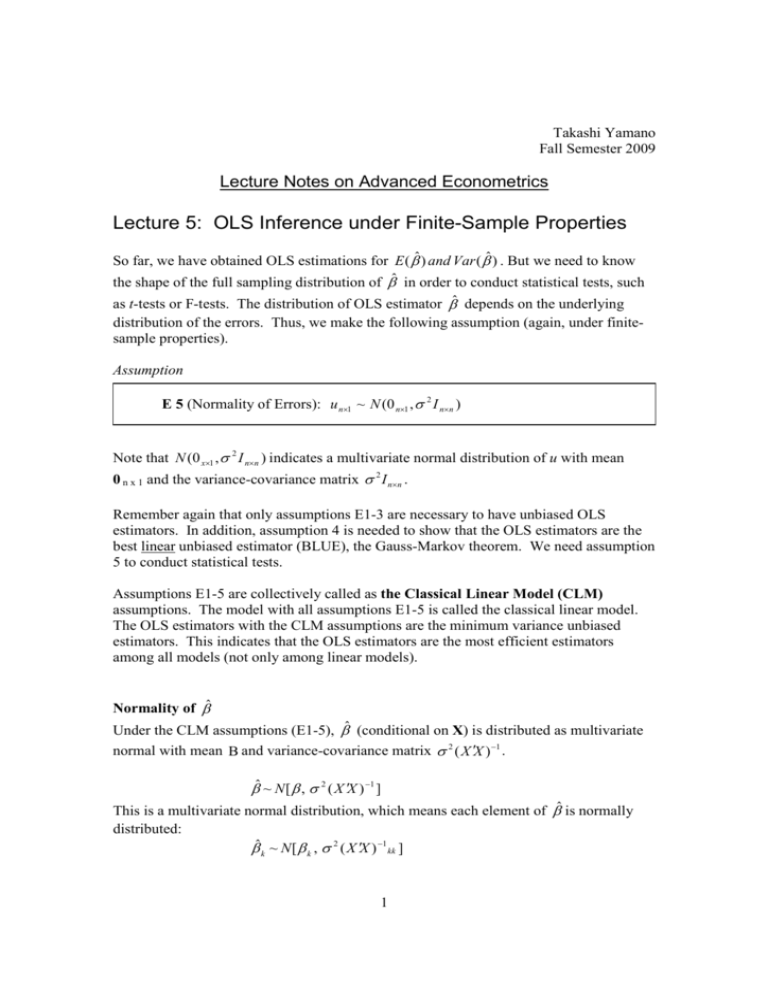
Takashi Yamano Fall Semester 2009 Lecture Notes on Advanced Econometrics Lecture 5: OLS Inference under Finite-Sample Properties So far, we have obtained OLS estimations for E ( βˆ ) and Var ( βˆ ) . But we need to know the shape of the full sampling distribution of βˆ in order to conduct statistical tests, such as t-tests or F-tests. The distribution of OLS estimator β̂ depends on the underlying distribution of the errors. Thus, we make the following assumption (again, under finitesample properties). Assumption E 5 (Normality of Errors): u n×1 ~ N (0 n×1 , σ 2 I n×n ) Note that N (0 x×1 , σ 2 I n×n ) indicates a multivariate normal distribution of u with mean 0 n x 1 and the variance-covariance matrix σ 2 I n×n . Remember again that only assumptions E1-3 are necessary to have unbiased OLS estimators. In addition, assumption 4 is needed to show that the OLS estimators are the best linear unbiased estimator (BLUE), the Gauss-Markov theorem. We need assumption 5 to conduct statistical tests. Assumptions E1-5 are collectively called as the Classical Linear Model (CLM) assumptions. The model with all assumptions E1-5 is called the classical linear model. The OLS estimators with the CLM assumptions are the minimum variance unbiased estimators. This indicates that the OLS estimators are the most efficient estimators among all models (not only among linear models). Normality of βˆ Under the CLM assumptions (E1-5), β̂ (conditional on X) is distributed as multivariate normal with mean Β and variance-covariance matrix σ 2 ( X ′X ) −1 . βˆ ~ N [ β , σ 2 ( X ′X ) −1 ] This is a multivariate normal distribution, which means each element of βˆ is normally distributed: βˆ k ~ N [ β k , σ 2 ( X ′X ) −1 kk ] 1 ( X ′X ) −1kk is the k-th diagonal element of ( X ′X ) −1 . Let’s denote the k-th diagonal element of ( X ′X ) −1 as Skk. Then, σ 2 S11 . . . . S11 . . . . . σ 2 S 22 . . . . S 22 . . . −1 2 2 σ ( X ′X ) = σ = . . . . S 2 kk . . . . σ S kk This is the variance-covariance matrix of the OLS estimator. On the diagonal, there are variances of the OLS estimators. Off-the diagonal, there are covariance between the estimators. Because each OLS estimator is assumed to be normally distributed, we can obtain a standard normal distribution of an OSL estimator by subtracting the mean and dividing it by the standard deviation: zk = βˆ k − β k σ 2 S kk . However, σ 2 is unknown. Thus we use an estimator of σ 2 instead. An unbiased estimator of σ 2 is uˆ ′uˆ s2 = n − (k + 1) uˆ′uˆ is the sum of squared errors. (Remember uˆ′uˆ is a product of a (1 x n) matrix and a (n x 1) matrix, which gives a single number.) Therefore by replacing σ 2 with s2, we have tk = βˆ k − β k s 2 S kk . This ratio has a t-distribution with (n-k-1) degree of freedom. It has a t-distribution because it is a ratio of a variable that has a standard normal distribution (the nominator in the parenthesis) and a variable that has a chi-squared distribution divided by (n-k-1). The standard error of β̂ k , se( β̂ k ), is s 2 S kk . Testing a Hypothesis on β̂ k In most cases we want to test the null hypothesis H0: β k = 0 2 with the t-statistics t-test: ( β̂ k - 0)/ se( β̂ k ) ~ t n-k-1. When we test the null hypothesis, the t-statistics is just a ratio of an OLS estimator over its standard error. We may test the null hypothesis against the one-sided alternative or two-sided alternatives. Testing a Joint Hypotheses Test on β̂ k ' s Suppose we have a multivariate model: y i = β 0 + β 1 x i1 + β 2 x i 2 + β 3 x i 3 + β 4 x i 4 + β 5 x i 5 + u i Sometimes we want to test to see whether a group of variables jointly has effects of y. Suppose we want to know whether independent variables x3, x4, and x5 jointly have effects on y. Thus the null hypothesis is H0: β 3 = β 4 = β 5 = 0. The null hypothesis, therefore, poses a question whether these three variables can be excluded from the model. Thus the hypothesis is also called exclusion restrictions. A model with the exclusion is called the restricted model: yi = β 0 + β1 xi1 + β 2 xi 2 + u i On the other hand, the model without the exclusion is called the unrestricted model: y i = β 0 + β 1 x i1 + β 2 x i 2 + β 3 x i 3 + β 4 x i 4 + β 5 x i 5 + u i We can generalize this problem by changing the number of restrictions from three to q. The joint significance of q variables is measured by how much the sum of squared residuals (SSR) increases when the q-variables are excluded. Let denote the SSR of the restricted and unrestricted models as SSRr and SSRur, respectively. Of course the SSRur is smaller than the SSRr because the unrestricted model has more variables than the restricted model. But the question is how much compared with the original size of SSR. The F-statistics is defined as F-test: F≡ ( SSRr − SSRur ) / q . SSRur / (n − k − 1) The numerator measures the change in SSR, moving from unrestricted model to restricted model, per one restriction. Like percentage, the change in SSR is divided by the size of SSR at the starting point, the SSRur standardized by the degree of freedom. 3 The above definition is based on how much the models cannot explain, SSR’s. Instead, we can measure the contribution of a set of variables by asking how much of the explanatory power is lost by excluding a set of q variables. The F-statistics can be re-defined as F-test: F≡ ( Rur2 − Rr2 ) / q . (1 − Rur2 ) / (n − k − 1) Again, because the unrestricted model has more variables, it has a larger R-squared than the restricted model. (Thus the numerator is always positive.) The numerator measures the loss in the explanatory power, per one restriction, when moving from the unrestricted model to the restricted model. This change is divided by the unexplained variation in y by the unrestricted model, standardized by the degree of freedom. If the decrease in explanatory power is relatively large, then the set of q-variables is considered a jointly significant in the model. (Thus these q-variables should stay in the model.) 4

